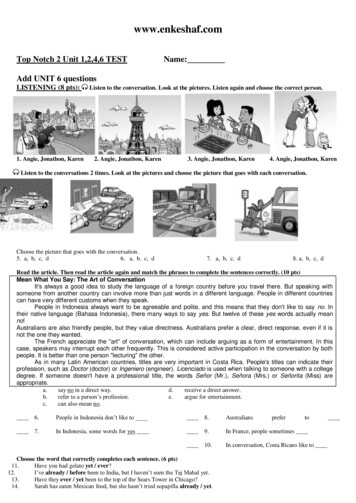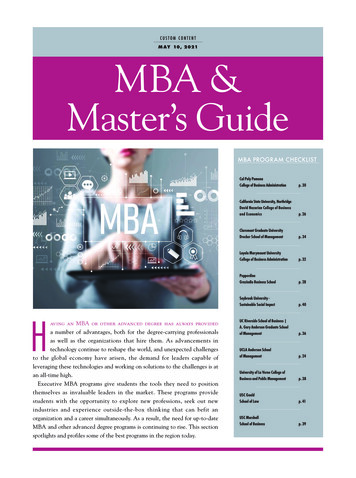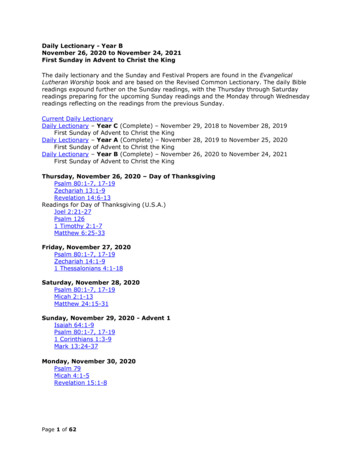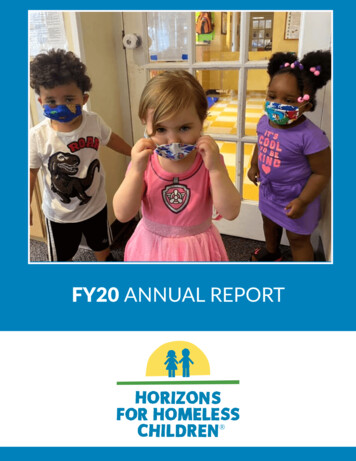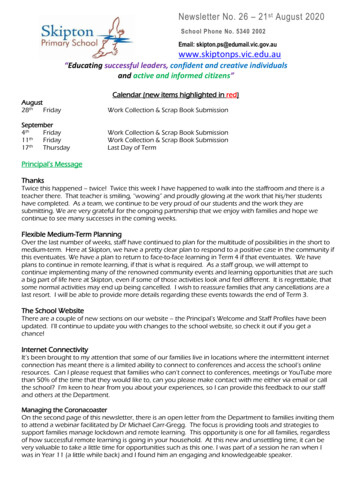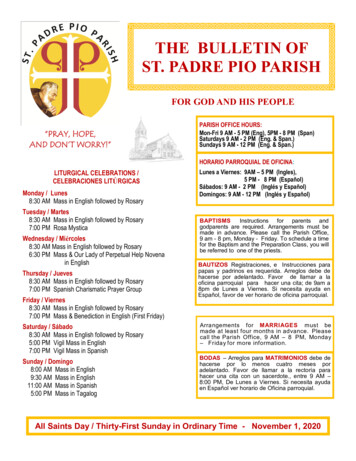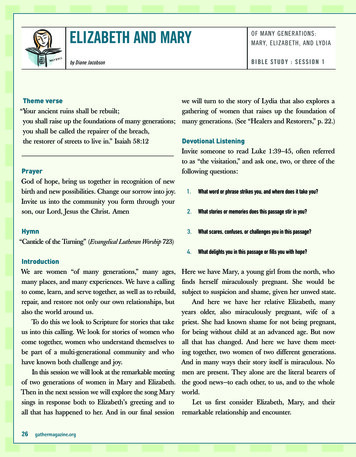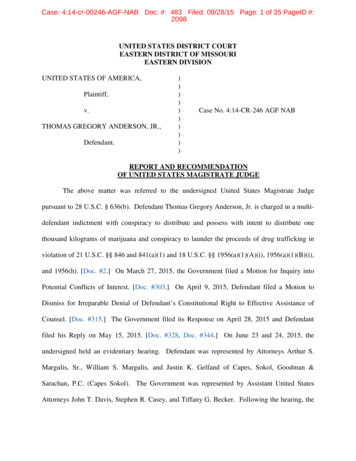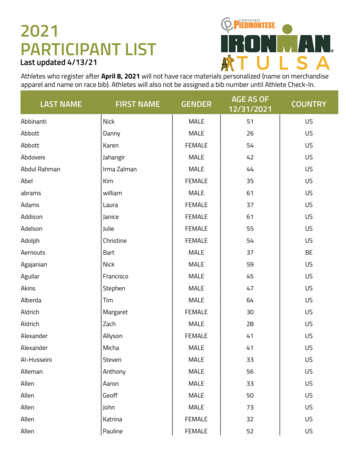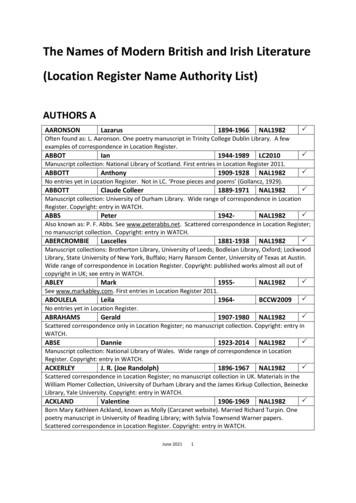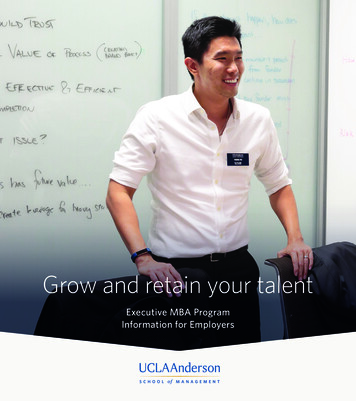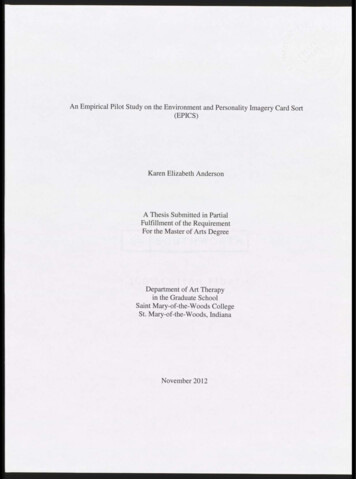
Transcription
An Empirical Pilot Study on the Environment and Personality Imagery Card Sort(EPICS)Karen Elizabeth AndersonA Thesis Submitted in PartialFulfillment of the RequirementFor the Master of Arts DegreeDepartment of Art Therapyin the Graduate SchoolSaint Mary-of-the-Woods CollegeSt. Mary-of-the-Woods, IndianaNovember 2012
Saint Mary-of-the-Woods CollegeGraduate Program in Art TherapyDateWe hereby recommend that the thesis submittedBy Karen Elizabeth AndersonEntitled: An Empirical Pilot Study on the Environment and Personality Imagery CardSort (EPICS)Be accepted in partial fulfillment of the requirements for the degree of Master of Arts inArt Therapy.Advisory Committee:ra&“’Pf. Jennifer MitchellDirectorDr. Lisa HinzReaderMichelle ItczakInstructorWe certify that in this Thesis all research involving human subjects complies with the Policies andProcedures for Research involving Human Subjects, Saint Mary-of-the-Woods College, Saint Mary-of-theWoods, Indiana.
SAINT MARY-OF-THE-WOODSTo:From:Date:Re:COLLEGEJill McNutt, ATR-BC, LPCKaren E. Anderson-Fignon, Graduate StudentJennie Mitchell, Ph.D., CPA, CMA, & Chair of the Human Subjects —Institutional Review BoardOctober 5, 2012Human Subjects Institutional Review Board ApplicationThank you for submitting a Human Subjects proposal entitled “An Empirical Pilot Study onCareer Best-fit Decisions Based on the Holland Themes of Personality and EnvironmentUsing the Environment and Personality Imagery Card Sort.”The Institutional Review Board (IRB) of Saint Mary-of-the-Woods College has approved yourresearch.Unless renewed, this approval will expire on December 31, 2013.If any changes need to be made during implementation of this research project, please submitthose changes to the IRB for its approval. Also, if any incidents occur, please notify the IRB assoon as possible.We wish you success with your research project.Institutional Review Board members:ChmetotedlJennie L. Mitchell, Ph.D., CPA, CMALamprini Pantazi, M.B.A.Brad Huffey, Ph.D.Sonja Frantz, Ph.D.Pam Sebura, Ph.D.
MiddlesexCommunitySeptember 25, 2012College—éBegy——Se ——i.stimoerr;Internal Review BoardSaint Mary-of-the-Woods College1 Saint Mary of the Woods CollegeSaint Mary of the Woods, IN 47876-0067Dear Colleagues,I'am pleased to inform you that Middlesex Community College in Middletown, Connecticut,has agreed to serve as a research site for Ms. Karen Anderson, a student in your Masters ofArts in Art Therapy program. The college will provide access to student subjects who willvolunteer to participate, and a conference room in which to conduct subject interviews, for herthesis entitled An Empirical Study on Career Best-fit Decisions Based on the Holland Themesof Personality and Environment Using the Environment and Personality Imagery Card Sort(EPICS). Ms. Anderson will work directly with my office on logistics that are mutuallyconvenient to the college, our students, and her research team.I met with Ms. Anderson to review the purpose of her study and her proposed methodology.Middlesex does not have an active Institutional Review Board at this time. Therefore, I soughtand received approval for this project from our Academic Division Chairs and collegepresident Dr. Anna Wasescha.Approval of this arrangement is made on the following conditions:Research may not begin until Middlesex Community College receives a copy of anApprovalLetter from the Internal Review Board of Saint Mary-of-the-Woods College.Research at Middlesex Community College may be conducted during the 2012-13academic year, and must conclude no later than April 30, 2013.Feel free to contact me if you have any questions about Middlesex Community College and/orour ability to support Ms. Anderson during her research on campus.Sincerely,resdumndl.Steven Minkler,Ed.D. Dean ofAcademic AffairsCc: Dr. Anna Wasescha
ABSTRACT“What do I want to do?” can plague an individual once he or she has completed his orher secondary education and beyond (Bolles, 2009).There is an abundance of tests andliteratures to help decide on a career path, however, there are limited assessments that useimagery as an aid. This pilot study will compare the accuracy in predicting the best-fitcareer or occupation for an individual using the Missouri Occupational Card Sort(MOCS) (Krieshok, Hansen, Johnson & Wong, 2002) and the Environment andPersonality Imagery Card Sort (EPICS), developed by the researcher.Both of these cardsorts use the proven Holland themes of personality and environment (Holland, 1987).The results of this study reinforces concrete perception made from images can be moreaccurate in exploring and discovering environments that are congruent with anindividual’s personality and points toward the EPICS being a viable tool for counseling.
ACKNOWLEDGMENTI would like to thank the Saint Mary-of-the-Woods (SMWC) faculty with specialappreciation to Michelle Itczak, Jill McNutt and Judy Tribble for their encouragementand support with this paper.I would like to acknowledge Lisa Hinz Ph.D. for herdedication to the field of art therapy and her positive approach to teaching.Without herencouragement to enroll in the Career Counseling course and continuing support, theEnvironment and Personality Imagery Card Sort would never have reached fruition. Ialso would like to thank my partner Andrew Russell for his ceaseless conviction andsupport of my becoming an art therapist, and my sister Jane who helped facilitate thepilot study. And to my children, Aniella and Ian, who have endured the countless“frozen” dinners and have found creative ways to get the everyday chores done so I couldfully embrace the program at SMWC and create EPICS.
TABLE OF CONTENTSCHAPTER5INTRODUCTIONStatement of the ProblemResearch QuestionBasic AssumptionPurpose and ObjectiveHypothesisDefinition of TermsII.Holland TheoryHolland’s Six Personality and Environment ThemesCareer DevelopmentVisual PerceptionCard SortingMissouri Occupational Card SortIII.METHODS/PROCEDURESResearch DesignParticipantsProcedure of Administering the Card SortIV.INSTRUMENTSDemographic DataMissouri Occupational Card SortEnvironmental and Personality Card SortAccuracy in Sorting Instrument
V.Data and Collection StorageFINDINGSFindingsVI.CONCLUSIONS, DISCUSSION, Cc.D.E.BEG.H.L1K.Demographic SurveyTest QuestionnairePersonal Response SheetMOCS Result FormEPICS Result FormConsent to Share Photograph/Artwork/Information FormEPICS Research with Human Participants Consent FormCareer and major Information of the Random PopulationDemographic Information of the Random PopulationTest Questionnaire Results
LIST OF TABLESTable 1.Career and Major Information of the Random PopulationTable 2.Results of the Missouri Occupational Card SortTable 3.Results of the Environment and Personality Imagery Card Sort
LIST OF FIGURESFigure 1. The Holland RIASEC Hexagon (Career Assessments, 2011)Figure 2. The Holland Hexagon with Themes (Rogue Community College, 2012)13Figure 3. The Holland Hexagon with Theme Descriptions (Career Assessments, 2011)16Figure 4. Visualizing Oneself More Accurately Using a Card SortFigure 5. Representation of Interests More IntuitivelyFigure 6. Accuracy in ResultFigure 7. Percentages of Participant Age GroupsFigure 8. Percentages of Male and Female ParticipantsFigure 9. Percentages of Participant’s EthnicityFigure 10. EducationFigure 11. Percentages of English as a First LanguageFigure 12. Social PersonalityFigure 13. Investigative PersonalityFigure 14. Realistic PersonalityFigure 15. Artistic EnvironmentFigure 16. Conventional EnvironmentFigure 17. Enterprising Environment
CHAPTER 1INTRODUCTIONStatement of the ProblemOne question most people have heard from elementary through high school is“What do you want to do when you grow up?” The public school system in the UnitedStates 1s designed for a student to spend 12 years in an educational program beforeenrolling in college or entering the job market.The standard courses taught are English,mathematics, science, social sciences, history, language, art, music, and physicaleducation, which are supplemented with clubs, activities, and sports, to expose andprepare students for various vocations and career paths.However, more than 80 percentof students end their senior year in high school not knowing what to major in (Ronan,2005), which university to apply to, and what type of job will provide the structure,environment and socioeconomic position that would best fit their particular interests andaptitude.Of the remaining 20 percent that have declared a major in their freshman year,50 percent will change their major two to three times before they graduate from college(Ronan, 2005).Because of this, young adults experience stress in making a decisionabout a field of study or profession, which can cause emotional and socioeconomicdistress (Bolles, 2009; Ronan, 2005).students.This quandary is not limited to high schoolThe question, “What do I want to do?” can plague an individual once he or shehas completed his or her secondary education (Bolles, 2009) and beyond.To help with career decisions, there are an abundance of assessments andpublished literature about occupational choices and career paths. There are tests, such asstrength inventories, personality trait measures, environmental assessments, card sorts,
computerized programs and surveys (Gysberg, Heppner & Johnson, 2009) that measureaptitude, interests, and abilities. Instruments used by career counselors and coaches areknown as assessments, tools, tests and measurements.These terms are usedinterchangeably throughout this document, as are the words student, individual, youngadult, subject and participant.The Clifton StrengthsFinder, the Strong InterestInventory, the Self-Directed Search, Missouri Occupational Card Sort (MOCS) and thePrinceton Review’s Career Quiz (Ackerman & Beier, 2003; Bolles, 2009; Gottfredson,2002; Gysberg et al., 2009; Rottinghaus, Day & Borgen, 2005) are some of theassessments commonly administered at career centers, and some can be found online asself-directed tests. These tools evaluate an individual's occupational interests in depth,and then match his or her work values, skills and aptitude with a particular occupation(s).The goal of administering assessments is to produce a prediction or outcome of a positiveand relevant career path tailored to the individual according to the results (Krieshok,Hansen, Johnson, & Wong, 2002).So what makes exploring different career paths and career decision-making sostressful? Often, young adults have preconceived ideas about a particular careerdescription, predetermined job paths that are influenced by their parents’ desires,unrealistic occupational expectations, and invalid assumptions (Figler & Bolles, 2007;Gysberg et al., 2009; Yost & Corbishley, 1987).Other obstacles that make careerdecisions difficult are external barriers that inhibit and/or deter the exploration ofalternative vocational opportunities.These are due to misinformation, unclear careerdescriptions, socioeconomic issues and tainted ideas from others (Figler & Bolles, 2007;Gottfredson & Duffy, 2008).
There are various theories and approaches used by professionals to help anindividual select an occupation or career path. One theory is the social-cognitive careertheory, which uses the notion that an individual will draw upon cognitive factors and“incorporates Bandura’s triadic reciprocal model of causality, which assumes thatpersonal attributes, the environment and overt behaviors” (Niles & Hartung, 2000, p. 30)operate and affect each other in a bidirectional way as “an interconnecting mechanism”(Niles & Hartung, 2000, p. 30) when developing and making career decisions.Both theHolland theory of themed interests with personality types and environments congruence(Gysberg et al., 2009; Holland, 1997; Soicc, 2008) and the “Big Five” personality traits(Openness, Conscientiousness, Extraversion, Agreeableness and Neuroticism) (Betz &Borgen, 2010; Bullock & Reardon, 2008; Reed, Bruch & Haase, 2004), are theories wellknown in the field of career development and assessment, and have a strong relationshipthrough meta-analysis studies (Bullock & Reardon, 2008; Hartman & Betz, 2007).One type of assessment is a card sort. Card sorts are a process orientatedassessment that is an alternative to the typical pencil response tests, which focus on theoutcome rather than prediction of career direction (Krieshok et al., 2002).Card sorts aremade up of individual cards that have a written job title on one side and the jobdescription on the opposite side. The objective of the card sort is to have the participantread the title and descriptions on the card and then sort the cards into different piles suchas likes, dislikes, and maybes.The MOCS, first developed by Hansen and Johnson in 1976 (Krieshok et al.,2002), uses the validity and reliability that is roughly equivalent to that of comparableinterest inventories.The MOCS is a deck consisting of ninety cards, each representing an
occupation.The card front consists of an occupational title and corresponding number.The back bears the corresponding three-letter Holland code for the specified occupation,the Dictionary of Occupational Titles (D.O.T.[a nine digit reference locator])(Gottfredson & Holland, 1989), with a brief description of responsibilities and primaryactivities (Bikos, 1995; Holland, 1997; Krieshok et al., 2002).The Holland code refers tothe six RIASEC (Realistic, Investigative, Artistic, Social, Enterprising, Conventional)groups characterized by 15 cards within the deck.This interactive card deck requires theparticipant to sort the cards into three categories: “Like,” “Dislike,” or“Undecided/Neutral.” The participant then looks for common themes and ranks the topten results to pursue as an occupation.The Environment and Personality Imagery Card Sort (EPICS), developed by theresearcher, 1s a tool to aid in career decision-making by using imagery to representpersonality and environmental themes consistent with the Holland themes (Holland,1997).The EPICS establishes a person-environment congruence (Gottfredson & Duffy,2008) through manifesting a concrete perception.This concrete perception is formedwhen an individual projects him or her self into the image and incorporates his or herinfluential emotions and intuitive elements.By using the language of vision, the mindtakes into consideration the colors, forms, images, any emotional connection, andexperienced references and, in a few seconds (Gladwell, 2005), links it to personalexperience, interests, personality traits, and biases.The EPICS card(s) has an image(s) on one side of the card and correlatingHolland theme on the reverse.It uses the same sorting process of making piles. Thedifference between the MOCS and the EPICS are the approaches to sorting. The MOCS
uses a cognitive approach with written titles, while the EPICS uses a visual approachwith imagery, creating a concrete perception.Research QuestionWill results from the participation in Environment and Personality Imagery CardSort (EPICS) and Missouri Occupational Card Sort (MOCS) reveal a clearer responseusing a visual/intuitive/emotional approach with projected concrete perceptionsmanifested by a visual representation of a career (EPICS), or by using a cognitiveapproach where the career title and descriptions are written on a sorting, such as theMOCS,which the participant reads?Basic AssumptionThe basic assumption of this study is that a young adult will respond mreaccurately when using EPICS because they make an intuitive and emotional connectionwith the images on the cards. This connection is the catalyst that manifests the concreteperception.Using this concrete perception, the individual projects him or herseif into theenvironment of the image, linking his or her emotions, underlying thoughts, ambitionsand experiences, to the perceived career. The images will tap into the individual’sconscious and unconscious likes and dislikes, ultimately influencing the reasons foracceptance or rejection of the card.The EPICS will aid young adults in clarifying types of vocational environmentsthat would best fit their personality and aptitude.Participants will be able to projectthemselves into the environment represented through concrete perceptions formed by theimage on the card. Responses derived from emotional, intuitive, and other abstract
perceptions can be incorporated into the projection, using the semi-structured format ofsorting.The EPICS can help explore opportunities that the individual may not havepreviously considered.The rationale behind this is that the individual may experiencelimitations due to language, cultural, cognitive factors and other constraints in the MOCSand other occupational assessments that are eliminated by use of the image.Byeliminating the written component, such as title and description, during the sortingprocess, the individual can connect with the environment represented on the card withouthaving preconceived barriers or obstacles.One example of connecting with the environment represented on the card wouldbe that an individual who likes to work alone would be drawn to an image that lias anindependent figure or isolated work space, while a socially inclined individual would bedrawn to people working together in a group activity. This connection has been calledthe “person-environment congruence” (Gottfredson & Duffy, 2008).Another examplemay be a student, who does not know that anthropology involves the study of humankindas it interacts with culture, biology, social customs and beliefs, rejecting the written title“Anthropology” as a major simply due to a lack of knowledge about the subject.Therefore, it was this study’s assumption that a young adult using, EPICS will establishperson-environment congruence through a concrete perception, incorporating emotionand intuition.Purpose and ObjectiveThe purpose of this study was to establish a foundation where an individualpredominately responds truer to their self when a concrete perception is manifested
through visual representation when making career choices.This foundation willincorporate a platform of goals to be determined when taking the EPICS.These goalsare:to engage the individual to differentiate between likes and dislikes (Krieshok etal., 2002; Krieshok, Hansen, Johnson & Garson, 2002, January) within thecontext of (a) environment, (b) social interaction, and (c) emotional responsesto eliminate external barriers that may prevent the individual to explore othercareer paths including (a) language, (b) culture, (c) economic, and (d) familyinfluences (Figler & Bolles, 2007; Gottfredson & Duffy, 2008)to allow the individual to create a concrete perception influenced by (a) intuition,(b) emotion,(c) past events, and (d) experience (Figler & Bolles, 2007: Gysberget al., 2009)to reduce potential obstacles caused by aspects of his or her personality whenexploring career opportunities (Bolles, 2009; Figler & Bolles, 2007)to aid an individual in discovering a career that will satisfy vocational behaviorssuch as (a) satisfaction and well-being, (b) vocational personality, (c) individualand environmental identity, (d) environmental type and person-environmentcongruence, and (e) work values (Cotter & Fouad, 2011; Figler & Bolles, 2007;Gottfredson & Duffy, 2008; Gysberg et al., 2009; Krieshok et al., 2002; Krieshoket al., 2002, January).HypothesisIt 1s hypothesized that subjects will be better able to project themselves into afuture vocation when they see a pictorial representation of an environment as compared
with a written description of an occupation.This study will use imagery to create anenvironment and/or personality based on the RIASEC themes in a card sort assessment.It is hypothesized that an individual, when visually stimulated, will manifest concreteperceptions evoked from the imagery.These concrete perceptions will: (1) intuitivelyincorporate an individual’s preferences, emotions, experience and reasoning into aresponse; (2) provide immediate insight into the represented theme (Krieshok et al., 2002;Krieshok et al., 2002, January); (3) promote clarification to likes, dislikes and maybeswhen viewing a pictorial representation of a theme (Krieshok et al, 2002; Krieshok et al.,2002, January); (4) promote well-being and self-satisfaction (Cotter & Fouad, 2011;Gottfredson & Duffy, 2008) as well as support self-identity (Ronan, 2005); and (5)establish an environment(s) that is congruent with an individual’s personality, workvalues, skills, and aptitude (Gottfredson & Duffy, 2008).Definitions of TermsDependent variable- is the result of the element that is manipulated or changed from anintervention (Kapitan, 2010).Empirical- are studies that gain their data from experience or direct observation (Kapitan,2010).Environment and Personality Imagery Card (EPICS) - is a career guidance instrument ofone hundred eight cards that identifies the Holland themes on one side using imagery,with correlating personality/ environment on the opposite side.Guttman scale- uses a sequential rating system of responses from a series of statements tocreate a one-dimensional continuum scale that measures a specific concept (Trochim,2006).
Holland themes- are six personality and environment types: Realistic (R), Investigative(I), Artistic (A), Social (S), Enterprising (E), and Conventional (C) used in some careerassessments (Holland, 1997).Independent variable- 1s the element that is changed during an intervention while allother elements remain constant (Kapitan, 2010).Likert scale- 1s a psychometric scale that uses a sequential rating system of responsesfrom a series of statements (Trochim, 2006).Minimal risk- describes the research participants’ risk level exposure in a specific studyequivalent to that of the same amount of risk in their daily activities or psychologicalanalysis (Kapitan, 2010).Missouri Occupational Card Sort (MOCS)- 1s a career guidance instrument of ninetycards that identifies occupational titles on one side, with their descriptive information onthe opposite side (Krieshok et al., 2002).Mixed design- has components of quantitative and qualitative data within the overallcollection of responses (Kapitan, 2010).Person-environment congruence- is a harmony between the individual's personality traitsand the environment that rewards and allows communication of their values and pursuesopportunities (Gottfredson & Duffy, 2008).Pictorial- refers to the representation of concrete perception through the use of images.Protocol- 1s a fixed set of instructions not to be deviated from (Kapitan, 2010).Projection- 1s the ability to place oneself into an environment or image.Qualitative- research model identifies reflection and themes, through exploratory analysis(Kapitan, 2010).
10Quantitative- research model records the measurement and controlling of variables withina study (Kapitan, 2010).Randomization- in a study is the selection of a sample that represents characteristics of aspecific population (Kapitan, 2010).RAISEC- stands for the Holland codes (Realistic, Artistic, Investigative, Social,Enterprising, Conventional) for describing a person’s personality and environment types(Holland, 1997).Reliability- documents consistency in performance and quality within a study (Kapitan,2010).Self-Directed Search- is a career guidance instrument that estimates an individual’sprofile or personality pattern as it correlates to the Holland themes (Holland, 197).Single-Subject- is a model for a study that includes pre- and post-test evaluation on agroup of participants who are both the experimental and control group (Kapitan, 2010).Validity- is the measurement of internal and external variables that support the intendedpoint (Kapitan, 2010).123 career test- is an online test to provide insight into your personality test using theHolland codes (Anderson-Fignon, Gregory, & Gross, 2011).
CHAPTER IIREVIEW OF THE LITERATUREIn our culture today, interest in self-actualization and meaningfulness in our liveshas gained ground as literature floods the shelves of bookstores and on-line sites. One ofthe keystones of career choice in literature is the concept of environment and personalityas integral parts of a meaningful and successful career as in the Holland themes. Careerassessments have incorporated the Holland themes of Realistic (R), Investigative (I),Artistic (A), Social (S), Enterprising (E), and Conventional (C) maintain the reliabilityand validity of the RIASEC instrument.Figler and Bolles, renowned leaders in the careerdevelopment field, encourage the use of the Holland codes and the identification oftransferable skills, which can be correlated to specific vocations (2007).such as John L. Holland’s Self-Directed Search (SDS), MOCS,Instrumentsand the 1 2 3 test on-lineoccupational picture sort can be used to identify six common types of environments,personalities, skills and values in exploring career choices (Anderson-Fignon, Ciregory &Gross, 2011).Holland TheoryJohn Holland Ph.D.was a career development theorist who developed a conceptabout career choice based on the premise that there is a direct correlation between aperson’s personality and the work environment in which they feel most comfortable.This congruency is seen as a “fit” for a career or vocational avenue for an individual andpredicts where he or she will most likely be happiest and would thrive in his or hercareer. This compatibility is divided into six themes of people and work environments.Holland has spent years developing and clarifying his themes of personality and
environment.There are six principles that form the fundamentals of the Holland themes(1997),The choice of a vocation is an expression of personality (p. 7)Interest inventories are personality inventories (p. 8)Vocational stereotypes have reliable and important psychological andsociological meanings (p. 9)The members of a vocation have similar personalities and similar histories ofpersonal development (p. 10)Because people in a vocational group have similar personalities, they willrespond to many situations and problems in similar ways, and they will createcharacteristic interpersonal environments (p. 11)Vocational satisfaction, stability, and achievement depend on the congruencebetween one’s personality and the environment in which one works (p. 11)The Holland themes, as demonstrated in Figure 1, are designed in a hexagonalmodel that allows for various combinations of the six themes as in describing three-themeinteractions (Turner, Unkefer, Cichy & Peper, 2011).According to Holland, thiscombination becomes a person-environment congruency or “fit” (Holland, 1997) and isessential because it takes into consideration an individual’s interests, skills, andpersonality traits. This fit helps a person accurately identify and explore personality traitsand interests in career options, through environmental exploration to circumvent anyproblems that may arise from career indecision, barriers etc. (Nauta, 2007).A person’sinterests are connected to his or her personality (Holland, 1997; Larson & Borgen, 2006)and are motivated by his or her interests in a particular environment.The individual’s
personality traits in turn influence the interactions within the environment (Larson &Borgen, 2006).By incorporating both personality and environment components, he orshe becomes an active participant in choosing their best career.Figure 1. The Holland RIASEC Hexagon (Career Assessments, 2011)REISHolland’s Six Personality and Environment ThemesThe six themes created by John Holland (Bikos, 1995; Holland, 1997; Krieshok etal., 2002; Soicc, 2008; Niles & Hartung, 2000) are represented by the acronym RAISEC.Each specific theme has both an environment and personality type associated with it.The following descriptions of the RAISEC give an overview of some of the featuresassociated with each environment and personality.
Figure 2. The Holland Hexagon with Themes (Rogue Community College, 2012)EnterprisingThe realistic person likes to work with animals or things such as machinery andtools and values practicality such as concrete perception rather than abstract ideas.Realistic people are notably mature, simplistic, determined and like to dominate theirenvironment that stresses technical skills. They avoid social activities such as teaching orhealing others (Bikos, 1995; Holland, 1997; Krieshok et al., 2002; Soicc, 2008; Niles &Hartung, 2000).The investigative person likes to solve or study science and math relatedproblems.They prefer abstract or intellectual thinking.They are self-confident, original,and have a high aptitude for verbal and math skills. They prefer working independentlyand avoid new people, groups, and interpersonal relationships.Investigative peoplewould avoid leadership, sales, or persuading people (Bikos, 1995; Holland, 1997;Krieshok et al., 2002; Soicc, 2008; Niles & Hartung, 2000).The artistic person likes to interact with feelings, creativity, and the imagination.They value aesthetic and intuitive qualities, elude direct relationships, prefer free andflexible schedules, and place less significance on political and material issues. Theyoften relate through their art, music, literature, or other artistic avenues and praise other
artistic- like individuals (Bikos, 1995; Holland, 1997; Krieshok et al., 2002; Soicc, 2008;Niles & Hartung, 2000).The social person likes to help others, is sensitive to others’ needs, and valuessocial activities and causes.Lacking in scientific and mechanical aptitude, they often areimpulsive, cheerful, and scholarly, using their verbal and social abilities to change others’behaviors.Social people are drawn to environments that help, cure, or enlighten otherssuch as social welfare and teaching (Bikos, 1995; Holland, 1997; Krieshok et al., 2002;Soicc, 2008; Niles &
Feel free to contact me if you have any questions about Middlesex Community College and/or our ability to support Ms. Anderson during her research on campus. Sincerely, resdumndl._ Steven Minkler, Ed.D. Dean of Academic Affairs Cc: Dr. Anna Wasescha . ABSTRACT "What do I want to do?" can plague an individual once he or she has completed his .
